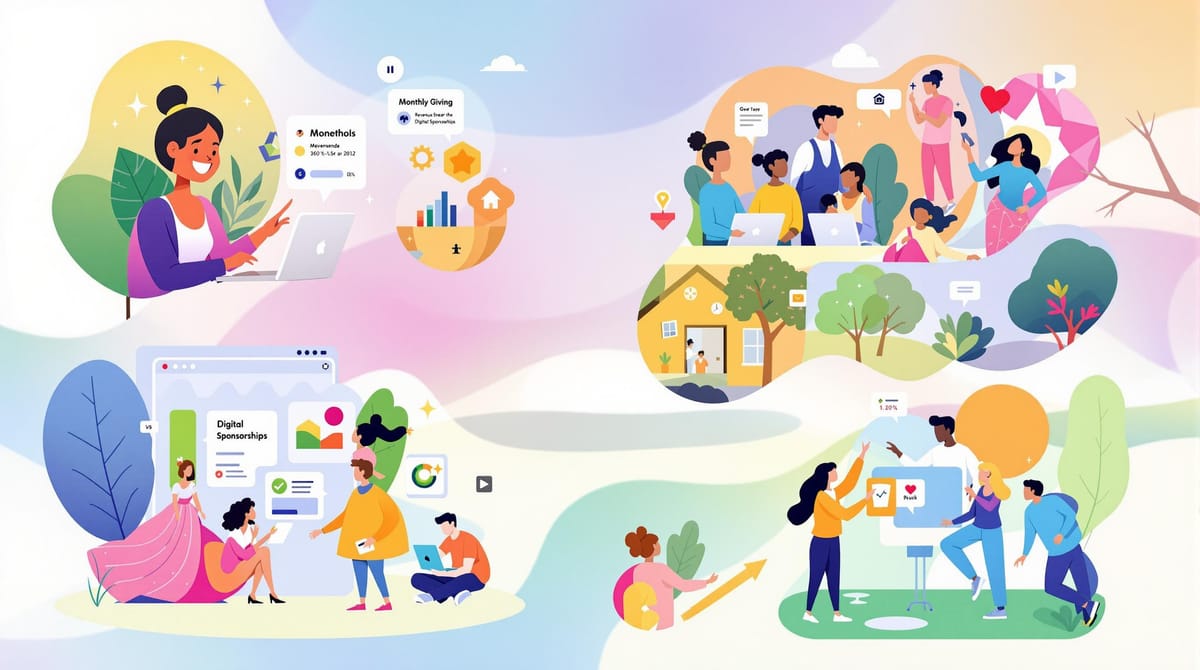Beyond Donations: Building a Digital Revenue Stream
Explore how nonprofits can diversify revenue streams through digital sponsorships, monthly giving, online stores, and fundraising tools for sustainable growth.

Nonprofits relying only on donations risk stagnation. Diversifying with digital revenue streams can boost growth by 66% compared to 11% for donation-only models. Here’s how nonprofits can secure steady income and reduce financial risks:
- Digital Sponsorships: Partner with sponsors aligned with your audience. Use analytics, custom packages, and virtual events for engagement.
- Monthly Giving Programs: Offer recurring donations with clear tiers and benefits. Donors give 40% more annually than one-time contributors.
- Online Stores: Sell mission-aligned merchandise to generate income and raise awareness.
- Fundraising Tools: Use platforms with secure payments, donor management, and analytics to streamline operations.
Quick Tip: Start small - apply for grants, enable donors to cover fees, and set up matching gift programs. Diversified income ensures stability and supports long-term goals.
Online Sponsorship Programs
Understanding Digital Sponsorships
Digital sponsorships provide nonprofits with a steady income stream by engaging supporters online. These programs connect sponsors with causes they care about while offering measurable benefits to both sides.
Success in digital sponsorships starts with knowing your audience. Joe Waters puts it this way:
"Companies look for audiences to tell them what is good, profitable and popular in the world. So it's not about whether you have a walk or run or a gala – or if those events are virtual or live. What matters is what type of AUDIENCE is participating in the fundraiser."
Once you understand your audience, you can start building your program.
Setting Up Your Program
Creating an effective digital sponsorship program takes careful planning and the right tools. Here are the key components most successful programs include:
| Component | Purpose | Impact |
|---|---|---|
| Audience Analytics | Track demographics and engagement | Attracts sponsors that align with your mission |
| Value Packages | Customized sponsorship options | Boosts sponsor return on investment |
| Digital Integration | Website and social media presence | Increases visibility and reach |
| Engagement Metrics | Measure sponsor impact | Proves the value of the program |
Nikita Patel highlights the importance of connection:
"Successful virtual sponsorships rely on making the sponsors feel connected to their target audience in a way that makes them feel at ease and confident."
Once your framework is ready, use these strategies to strengthen engagement.
Sponsorship Program Tips
To get the most out of your digital sponsorship program, focus on creating meaningful interactions. Here are some effective strategies:
-
Virtual Event Features
Include sponsors in event lobbies and presentation screens. Offer opportunities for direct interaction, such as sponsored breakout sessions or workshops. -
Creative Engagement
For example, one sponsor sent snack boxes to virtual attendees, creating a physical connection to the event. -
Measurement and Reporting
Track metrics like website traffic from sponsorship links, email click-through rates, social media engagement, and conversions to show sponsors the value of their investment.
Abby Clemence, Director of Infinity Sponsorship, offers this advice:
"If you're still sending out proposals that are also filled with gold, silver, bronze (GSB) levels, then you need to stop!"
Instead, tailor sponsorship packages to align with each sponsor's goals and audience. This customized approach has helped organizations increase sponsorship revenue by up to 3.8x.
Monthly Giving Programs
How Monthly Giving Works
Monthly giving programs provide a reliable income stream through automatic recurring donations. On average, donors who give monthly contribute about 40% more each year compared to one-time donors. Using tiered membership models can help outline benefits clearly and encourage recurring contributions.
Here’s an example of how to structure your tiers:
| Tier Level | Monthly Amount | Benefits |
|---|---|---|
| Basic | $10–25 | Newsletter access and updates on the impact of donations |
| Supporter | $26–50 | All Basic benefits, plus exclusive content and recognition |
| Champion | $51–100 | All prior benefits, plus event discounts and community access |
| Leadership | $100+ | All prior benefits, plus special gifts and VIP experiences |
Once your tiers are set, you’ll be ready to develop a program that maximizes these benefits.
Creating Your Program
To successfully launch a monthly giving program, follow these steps:
- Set Clear Goals: Define SMART goals to track donor acquisition and retention.
- Choose the Right Platform: Use fundraising software that supports automated payments.
- Design Attractive Benefits: Offer perks that will appeal to your donor base.
- Optimize Donation Pages: Make monthly giving the default option and suggest donation amounts.
For instance, Canadian Feed the Children encourages donors to "become an everyday hero" by showing how their consistent contributions directly help children in need.
Kate Hawkes highlights the simplicity of these programs:
"Monthly giving programs are an incredibly efficient way of getting regular support for your nonprofit with barely any admin work needed. Because the donation is made automatically, your donors don't have to remember to fill out their details every month, and your organization can enjoy a steady and reliable source of revenue."
Monthly Giving Advantages
A well-executed monthly giving program offers several benefits that enhance financial stability and donor engagement.
Some key benefits include:
- Retention: Over 80% of monthly donors continue giving after one year.
- Efficiency: Automation reduces administrative tasks.
- Engagement: Regular donors often feel more connected to your mission.
- Planning: Steady income supports long-term growth strategies.
Organizations like Charity: water have successfully built communities around monthly giving with programs like "The Spring". By providing frequent donor updates and managing credit card details proactively, they ensure consistent contributions and avoid revenue disruptions.
4 Types of Recurring Nonprofit Revenue (WITH $ Estimates!)
Nonprofit Online Stores
Adding an online store to your nonprofit's strategy is a direct way to diversify income and engage donors more deeply, complementing efforts like digital sponsorships and monthly giving.
Why Start an Online Store?
An online store can help nonprofits generate income while spreading awareness of their mission. Selling merchandise not only brings in revenue but also acts as a form of mobile advertising, strengthening donor loyalty and building community connections.
Here are some key benefits:
| Benefit | How It Helps |
|---|---|
| Mission Alignment | Offers products that reflect your goals and avoid unrelated business income tax issues |
| Brand Awareness | Merchandise doubles as advertising when supporters use it |
| Donor Engagement | Buyers often become advocates, increasing community involvement |
| Revenue Growth | Provides a steady income stream beyond traditional donations |
Steps to Set Up Your Store
Follow these steps to create a nonprofit online store that aligns with your mission:
- Choose the Right Products
Pick items that tie directly to your mission. For instance, environmental groups could sell reusable water bottles, while veteran organizations might offer American flag–themed products.
- Set Up the Platform
Look at examples like The Girl Scouts, who successfully transitioned their cookie sales online while staying true to their mission. To get started:
- Integrate the store with your website
- Use secure, mobile-friendly payment systems
- Promote your store on social media to expand reach
- Develop a Marketing Plan
Promote your store using targeted campaigns:
- Send emails featuring new products
- Share impact stories on social media
- Encourage user-generated content with branded hashtags
- Offer special deals during fundraising events
Tips for Managing Your Store
Launching your store is just the start - ongoing management is key to success. Take inspiration from The Animal Rescue Site, which uses Facebook Marketplace effectively.
"Merchandise is like a walking billboard for your mission and should be interesting, on-brand, catchy, and memorable."
- Janelle Levesque, Director of Digital Growth, Tapp Network
Here are some tips to keep your store thriving:
- Review sales data quarterly to track performance
- Update your product lineup based on customer feedback
- Personalize thank-you emails to show the impact of purchases
- Use dropshipping to minimize upfront costs
- Monitor buyer behavior using analytics tools
For tax purposes, nonprofits earning over $1,000 from unrelated activities must file Form 990-T. Partnering with third-party providers can also simplify sales tax management.
A great example is Elephant Origins, which sells teas sourced from regions where their work supports Asian elephants, perfectly aligning their products with their mission.
Digital Fundraising Tools
Digital fundraising tools simplify donor engagement and support your organization's financial goals. They work alongside online stores, monthly giving programs, and sponsorships to automate tasks and strengthen connections with donors.
These platforms have reshaped nonprofit fundraising by making processes more efficient and improving how organizations interact with their supporters.
Key Platform Features
When evaluating digital fundraising platforms, focus on features that streamline operations and enhance donor satisfaction. Here are some key components to look for:
| Feature Category | Key Components |
|---|---|
| Payment Processing | Secure gateways, recurring billing, multiple payment options |
| Donor Management | Contact databases, segmentation, historical giving records |
| Campaign Tools | Customizable forms, email automation, social media links |
| Analytics | Real-time reports, donor insights, ROI tracking |
Studies show that 63% of donors worldwide are inspired to give again when they receive regular email updates about how their donations are making an impact.
Selecting Your Platform
The right platform should reduce manual work while supporting a variety of fundraising efforts. Look for platforms with:
- Automated workflows: Save time and improve donor convenience with self-service options.
- Multi-campaign support: Manage different fundraising initiatives in one place.
- Custom branding: Reflect your organization’s identity.
- Strong security: Protect sensitive donor information.
Integration is another critical factor. Your platform should work seamlessly with payment processors, email marketing tools, and other essential systems. Since email has a proven track record of boosting donor engagement, platforms with robust email automation features are a smart choice.
Platform Benefits
Using digital fundraising tools can lead to several measurable benefits:
-
Stronger Donor Engagement
On average, monthly donors contribute $948 annually. Additionally, 45% of online donors participate in recurring giving programs. -
Better Campaign Results
Promoting matching gift opportunities can increase donation revenue by as much as 19%. -
Increased Efficiency
These platforms automate routine tasks like donation processing, donor communication, impact reporting, and campaign tracking.
For example, Meta's Fundraising Tools have raised over $6 billion, with 89% of Facebook donors and 92% of Instagram donors contributing again.
Digital fundraising tools are essential for running effective campaigns, helping nonprofits stay organized, responsive, and results-driven.
Conclusion
Summary
Digital revenue strategies like sponsorships, monthly giving programs, e-commerce, and advanced fundraising tools are driving both financial stability and growth for nonprofits. Research shows that organizations with diversified revenue streams experienced a 66% growth rate, compared to just 11% for those relying solely on cash donations. The shift toward digital fundraising has created fresh opportunities for nonprofits to connect with supporters and build steady income sources.
Next Steps
Now that you have these insights, it's time to put them into action.
-
Evaluate Your Current Revenue Sources
Take a close look at your existing revenue streams. Identify areas where digital tools could make a difference and prioritize strategies that align with your goals. -
Focus on Quick Wins
Start with actions that require minimal effort but offer significant returns:- Apply for a Google Ad Grant to secure $10,000 in monthly ad credits.
- Enable donors to cover transaction fees.
- Set up employer matching gift programs.
-
Build Lasting Revenue Channels
Invest in strategies that provide long-term benefits, such as:- Launching a subscription-based monthly giving program.
- Opening an online store with branded merchandise.
- Using automated donor management systems to streamline operations.

